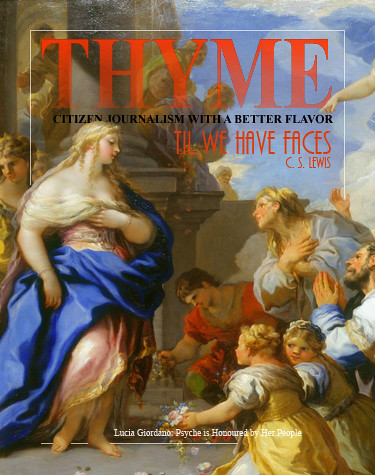
Volume XX, Issue X: C. S. Lewis's “Til We Have Faces”
A ‘Novel’ Presentation of Great Truth
C. S. Lewis wrote a book called The Abolition of Man in 1943. Subtitled “Reflections on education with special reference to the teaching of English in the upper forms of schools,” it uses that as a starting point for a defense of objective value and natural law as well as a warning about the consequences of doing away with them. It should be required reading in light of today's cancel culture. It defends “man's power over nature” as something worth pursuing but criticizes the use of it to debunk values, the value of science itself being among them. The book was first delivered as a series of three evening lectures at King's College, Newcastle, part of the University of Durham, as the Riddell Memorial Lectures on February 24 to 26, 1943. Larry Arn, President of Hillsdale College, Presents a course on this book and its ‘novel’ companion, That Hideous Strength. Lewis knew the power of story as one who studied the great myths and found in them the presentation of great truths. He presents further great truths in his book The Four Loves and its ‘novel’ companion ‘Till We Have Faces.’
Til We Have Faces, A Myth Retold
[click to read]
By C. S. Lewis
I am old now and have not much to fear from the anger of gods. I have no husband nor child, nor hardly a friend, through whom they can hurt me. My body, this lean carrion that still has to be washed and fed and have clothes hung about it daily with so many changes, they may kill as soon as they please. The succession is provided for. My crown passes to my nephew. Being, for all these reasons, free from fear, I will write in this book what no one who has happiness would dare to write. I will accuse the gods, especially the god who lives on the Grey Mountain. That is, I will tell all he has done to me from the very beginning, as if I were making my complaint of him before a judge. But there is no judge between gods and men, and the god of the mountain will not answer me. Terrors and plagues are not an answer. I write in Greek as my old master taught it to me. It may some day happen that a traveller from the Greeklands will again lodge in this palace and read the book. Then he will talk of it among the Greeks, where there is great freedom of speech even about the gods themselves. Perhaps their wise men will know whether my complaint is right or whether the god could have defended himself if he had made an answer. I was Orual the eldest daughter of Trom, King of Glome. (read more)
Easy to Teach, Hard to Blog About
[click to read]
A Pilgrim in Narnia
Though I am always nudging readers to see The Great Divorce as C.S. Lewis’ most genius work of fiction, Till We Have Faces truly is a remarkable novel. It is the dying-days journal of Orual, Queen of Glome, who sues her capricious gods for their unfairness to her. The writing is elegant, the portrait is intimate, the transformational element is intricately tied to the psychological development in Orual’s tale, and the fictional world is complete. I know of many people who resist Lewis’ work, but admit that Till We Have Faces is among the 20th century’s important novels. (read more)
The Four Loves
[click to read]
By C. S. Lewis
God is love," says St. John. When I first tried to write this book I thought that his maxim would provide me with a very plain highroad through the whole subject. I thought I should be able to say that human loves deserved to be called loves at all just in so far as they resembled that Love which is God. The first distinction I made was therefore between what I called Gift-love and Need-love. The typical example of Gift-love would be that love which moves a man to work and plan and save for the future well-being of his family which he will die without sharing or seeing; of the second, that which sends a lonely or frightened child to its mother's arms. (read more)
Walt Disney and Robert Moses

Robert Moses and Walt Disney with a model of the 1964 Fair.
They were two visionaries – whose inspiration went far beyond their acknowledged ‘fields of expertise.’ They both built large, creating great works and some huge mistakes along the way. They both wanted to build something that would outlast them and they came together in the building of the 1964 World’s Fair.
